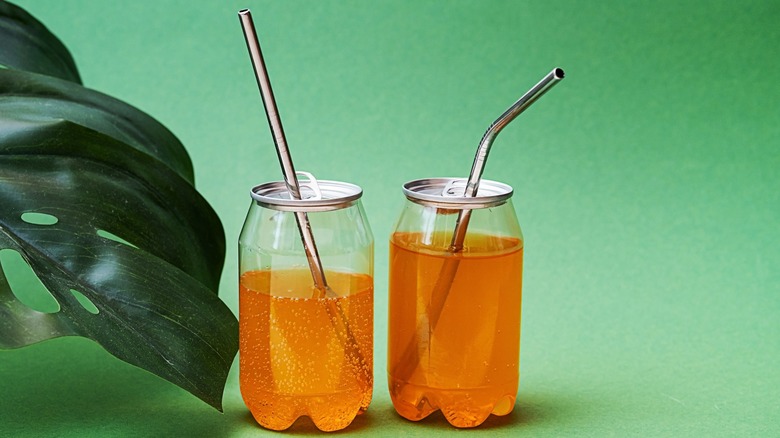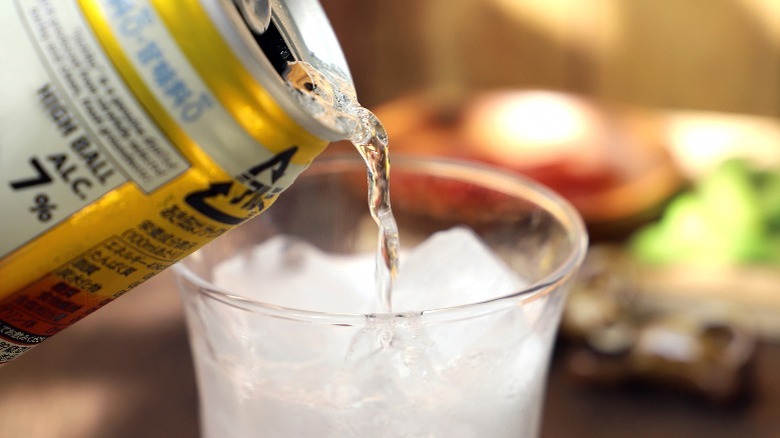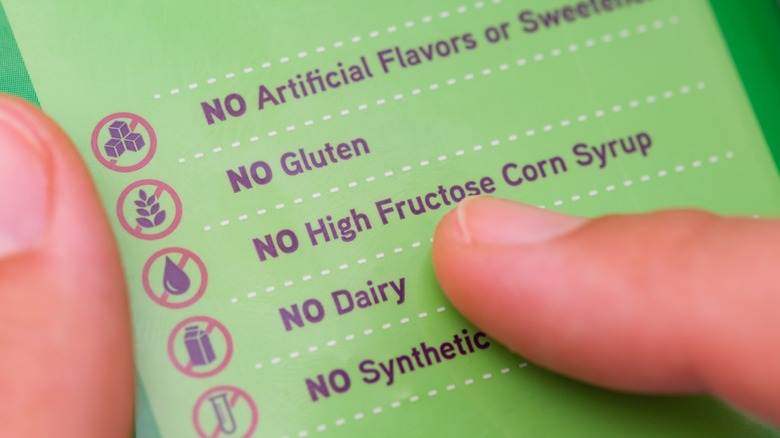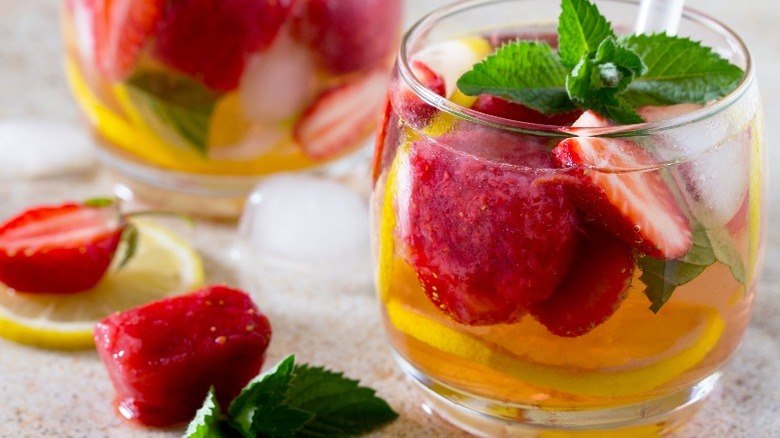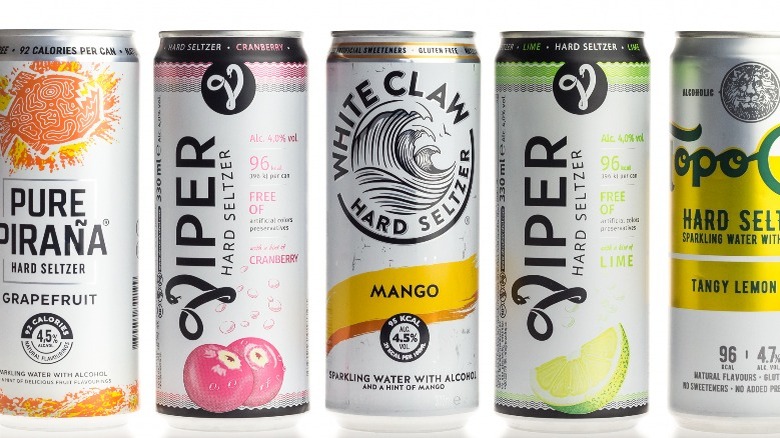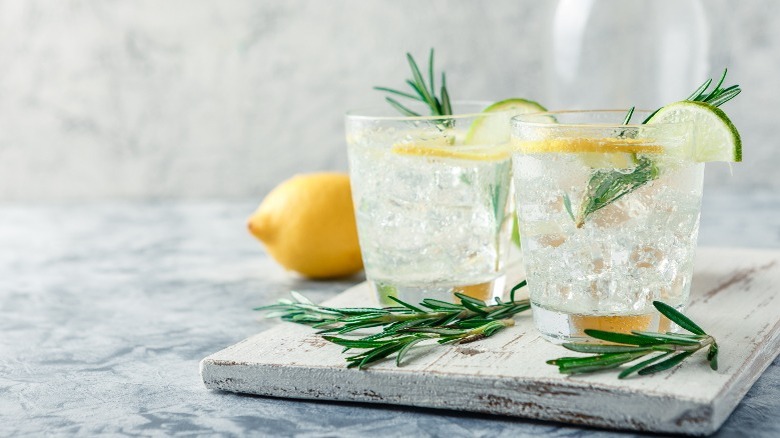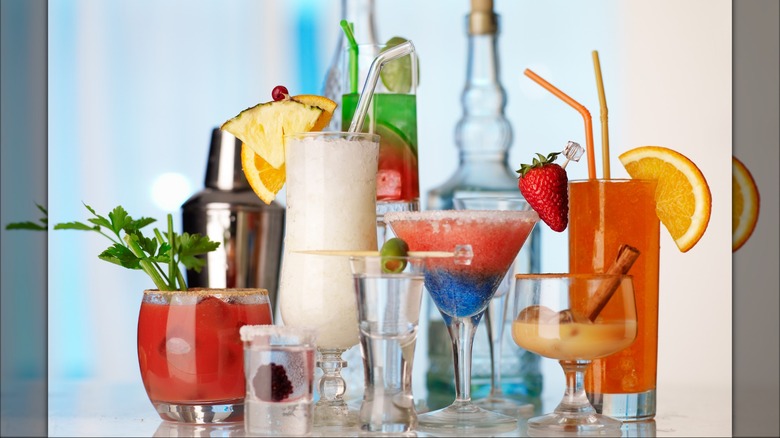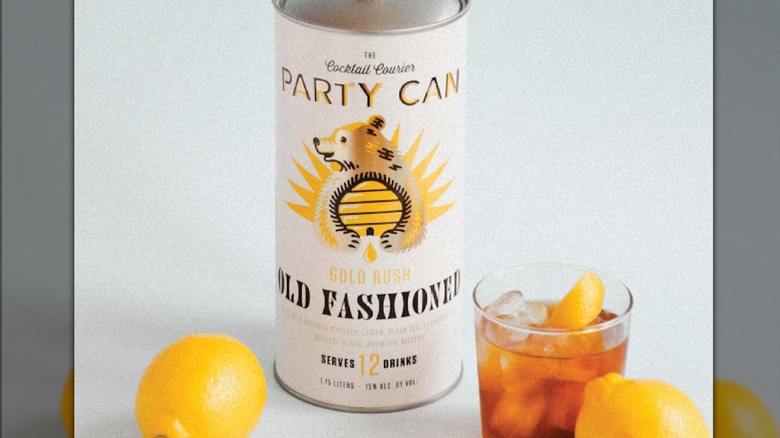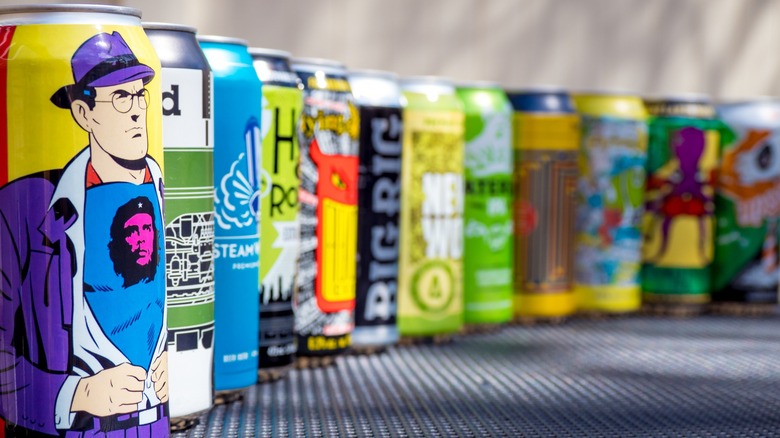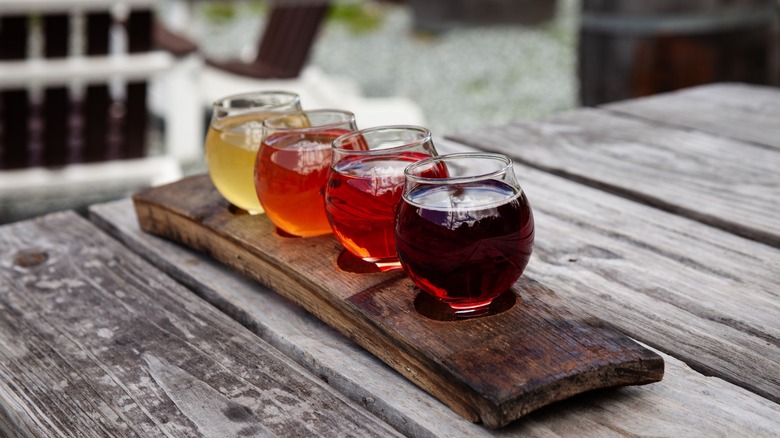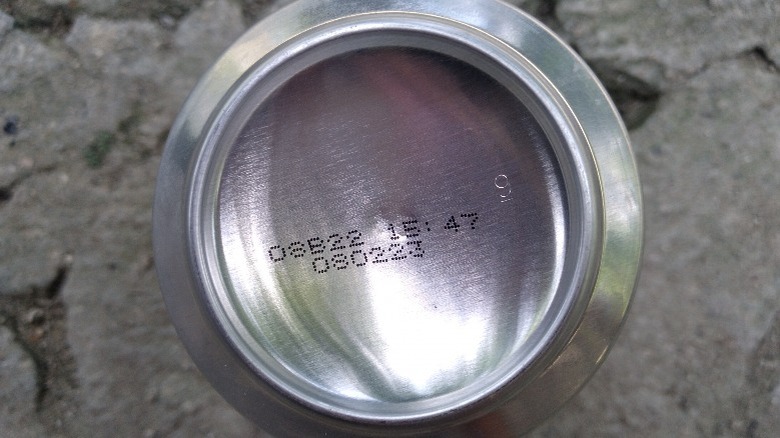11 Tips For Buying The Best Canned Cocktails
If your idea of summertime easy living means that you finally get to slip away from bartending duties and can actually spend some quality time lounging and sipping, then you're likely already aware of the explosion of canned cocktails available. Even if you've already tried a few, you might have some questions. And if you've been putting off trying some out, you likely have even more questions. We're here to guide you through some of those questions — everything from "Does it have to be hard seltzer?" to "Does everything have to be so fizzy?" And fear not, there are loads of options that are neither hard seltzer nor fizzy, as long as you know what to look for.
Canned (or bottled) cocktails aren't the sugary purple-hued coolers of yesterday, although those are still available if that's your jam. However, distillers have tapped into the trends of today and are now offering everything from small-batch Old Fashioneds to party-sized cans of tropical fruit-infused cosmopolitans. Pick up a couple of styles and see what appeals — there's a whole lot on offer.
Buy cocktails that are the closest to the real thing as possible
If you're looking for a decent sipping experience, try sticking to the closest iteration of the original cocktail recipe as possible. The occasional new twist on an old favorite is one thing but completely re-inventing a drink with loads of unusual flavors and ingredients while still calling a margarita isn't really helping anyone decide. You'll have to keep an eye while shopping though — a lot of these canned wonders, even while sticking to the original recipes, have the addition of carbonation even if the cocktail itself doesn't call for it. If you're looking for the classics, search out well-made versions that use top-quality spirits and mixes. Many distillers focus on crafting true-to-life versions of the libations that you, or a skilled bartender, could serve at home.
The truth about canned cocktails is that they offer a great way to try a variety of flavors and spirits, all while allowing you to spend some time away from the constraints of your bar cart. This means that you can, and should, try different beverages without having to invest in lots of different bottles. If you've been avoiding canned cocktails because of the versions you tried a decade ago, you're in for a pretty great surprise. There are still all sorts of malt-based (meaning all those super-popular seltzers) options but if your tastes have changed recently, rest assured that you'll be able to find dozens of recipes that taste like the real thing — because they are.
Avoid cans with loads of artificial flavors
Even if you decide to go with something fancier than the original iteration of the cocktail, avoid ingredients that aren't found in nature. A gin and tonic with real strawberry and rhubarb juice sounds amazing to us, but we'll always avoid anything with the addition of blue raspberry or anything neon blue, to be honest. The lab-created flavor was invented as a way for confectioners to avoid using the controversial Red Dye No. 2; no matter your stance on it, you still have to admit that it doesn't taste that great. So unless you're truly craving a grown-up version of the fizzy drinks you guzzled in primary school, you might want to give them a pass, too.
Scouting out cans that use true flavors and colors will give you a drink that tastes like it was served up by a true bartender, as well. Most high-end bartenders will rely on fruit juice and soda water, along with bitters, to create their cocktails, rather than a pre-mixed soda so look for those ingredients if you want the best experience. We're not condemning the high-sugar, wildly colored confections, if that's what you're into. Instead, we're just giving you the knowledge to go spirit-shopping with confidence. We'd be lying if we said that the occasional neon orange, creamsicle-flavored fizzy party pop didn't appear in our fridges.
Look for premium spirits
Another way to up your canned cocktail game is to search out cans put out by distillers of premium spirits. If you already know and love a specific brand, there's a very good chance that you'll also enjoy their to-go creations. A word of advice, however. Don't expect breweries to start churning out true cocktails. Instead, you'll likely find their offerings to be mostly just tropical-flavored versions of their best-selling beers. If beer cocktails, like the Edna's Lunchbox, are your thing, then you might have just found your happy place. If that's not what you're looking for, you might want to skip the beer-based beverages and search out the ones with familiar liquor names you know and love. Not only that, if you're lucky enough to live someplace where local bartenders and small distilleries have gotten in on the action, you might be able to find some of their offerings, too.
The beauty of canned cocktails is that you only have to buy one of anything that interests you so you're not spending a fortune on something that doesn't quite taste right. For the inexperienced, it can be hard to know what makes a spirit "premium", beyond price point. Liquor is generally considered premium when it has been aged for three years or more, so the only way to truly know is to visit the website, honestly. Still undecided? Take a spin through our selection of liquors you should (and shouldn't) be drinking for some good advice.
Avoid hard seltzers
If one of the reasons you've stayed away from canned cocktails is that you can still taste the hangover from the hard seltzers of our youth, fear not. What we're talking about here are canned cocktails made with real ingredients and premium liquors, not the sugar-packed, malt-liquor beverages of the past. Even current canned seltzers, like the hugely popular White Claw or Topo Chico, are still made with malt liquor and no premium spirits in sight. While ready-to-drink canned cocktails are gaining in popularity, hard seltzers are still a huge part of the market which means that someone is still drinking them.
So what is malt liquor, anyway? Closer to beer than to a spirit, malt liquor is little more than water, sugar, yeast, and some flavoring. The sugar and yeast ferment until the mixture gets suitably boozy, then water and flavor are added until the whole thing is drinkable. Seltzers took off for easy summer sipping and continue to gain popularity for people looking for low-carb and low-ABV (alcohol by volume). But that's not to say that they're particularly delicious — the process of making seltzer leaves it with little discernable taste (they rely on scent to make up for the lack of sugary flavor) and are highly carbonated. Because of these things, however, lots of consumers have found that they actually make a pretty decent mixer when better spirit is added.
Take care when shopping for citrus-based beverages
As much as we've harped on natural ingredients, we do have to warn you about citrus. The problem here has a lot to do with acidity and chemistry and all that kind of thing. What it comes down to is this: Citrus just doesn't preserve well. The fresh stuff isn't particularly shelf-stable; we're talking about four days at most before it starts going off, especially when used in a product that can go for months at a time mostly unrefrigerated. One of the best ways to preserve it is through pasteurization. This process works to keep it stable yet it robs citrus of the brightness and punchiness that makes it such a tasty ingredient in fresh cocktails.
Not only that, but the acidity of citrus combined with the metal can plus the inevitable march of time will often result in a tinny bitterness that results from the oxidization that is part of the pasteurization process. Not just bitterness, either. The descriptor "soapy" came up in our research more times than we're comfortable with. So what's a lime-loving imbiber to do? If you can find a cocktail that uses essential oils (made from the peel of citrus fruits) give those a go. You should find that they have a true taste with little oxidized distortion. Another option is concentrated (or comminuted) fruit juices — a process that purées the fruit, giving your cocktail a little more heft and viscosity.
Watch out for carbonation
As mentioned previously, the majority of canned cocktails have been given a bit of a party makeover with the inclusion of tropical flavors and a boost of carbonation. And while we're not out to disparage anyone's taste in cocktails (if you love a fizzy cosmo, we say knock yourself out), just be on the lookout for bubbles in everything, everywhere. You might find yourself disappointed if you were looking forward to a pre-made espresso martini, only to find it burbling over the side of your martini glass. You can still add some froth by pouring your canned espresso martini into a cocktail shaker and giving it a little action before pouring it. Maybe not a trick to try at the beach but it will definitely add to your bartender credibility at your next party.
Connecting to our previous point about the perils of citrus juice in cans, you'll remember that we brought up oxidization. Bubbles equal carbonization which equals oxygen, making it even more likely that your 100% pure lime juice is going to taste extra funky because of the addition of the bubbles. If you do want bubbles and citrus, go with a can that says "natural flavors" or "natural extracts" rather than pure juice.
Be aware of variations in alcohol content
Part of the appeal of these canned lovelies is that you can choose your level of alcohol without relying on eyeing an ounce yourself. There are so many lower-ABV options out there when it comes to delicious beverages that you can pretty much choose your own boozy adventure without having to limit your evening to glass after glass of ginger ale. Whatever your reason for imbibing less, from having to work in the morning to just reducing overall consumption, you can still try a few flavors without compromise.
While you're experimenting with the many options out there, make sure that you're taking a look at the ABV so you're not surprised when you crack one open later. Even if you're not consciously cutting back, it might make a difference when your comparing cans later on — that tour of canned piña coladas might have a different ranking if your options all contain wildly ranging amounts of rum. In fact, some of the canned cocktails we've been sipping all summer range from 4 to 31% alcohol by volume so there's a sweet spot for every imbiber, no matter what you're looking for.
Check out large-sized options to serve a crowd
Not only do canned cocktails deliver if you're wanting to try a lot of different options, but now producers are getting in on large-size cocktail kegs to serve a crowd. With one big can, you can dole out enough icy-cold margs to satisfy you and your friends on your afternoon in the sun. While the options are still limited currently, we can see how this trend will take off and there will soon be tons of options for your next pool party or roof-top soirée.
Cocktail Courier has three options in its 12-serving can — including cosmopolitan, old-fashioned, and the original triple-spiced margarita. Once you find a flavor you like, these big servings take the work out of mixing up pitcher after pitcher, leaving you to focus on your favorite summer activity from disc golf to slathering yourself with SPF. Other companies are finally getting in on the trend so you should start seeing party-size offerings more often.
Take the opportunity to try something new
If you haven't set out to buy cans yet, you'll likely be overwhelmed (to say the least) by the myriad options out there. Seriously, we're talking shelf after shelf of cute, colorful cans that promise the best of summer. Every flavor imaginable is supported with nearly every boozy backer you've ever heard of (and loads that you haven't). Fortunately, the price point of buying a single can means that you'll be able to try out a few options to see what you prefer. Don't believe us about citrus juice? This is the time to do a few taste tests of your own. Search out new tropical fruits or flavor combos that you never knew existed. Or finally give in and try a mai-tai after wondering all these years.
Even after giving you all this advice, we're still going to try whatever seems fun. Like these new fruity rum mixes from Red Stripe, the Jamaican brewery. Just because we love sharing our knowledge with you, it doesn't mean that we're impervious to the occasional "Oh why not?" moment. In fact, this vodka seltzer from SunnyD is giving us some serious summer nostalgia, no matter how much we think we might regret it.
Understand the difference between large vs small-batch distillers
There's more to know about large and small-batch distillers apart from their size. Obviously, that's the biggest thing that differentiates them but there is a little more to the story than that. A large-batch distillery often means that the company has been around for a longer time and has had a few successes under its belt, it will also have the financial means to reach a much larger audience. This also means that the distillery caters to the mass populace and the products will tend to appeal to the majority. More average products with the occasional trendy limited edition item but rarely anything too out-of-the-box.
Small distillers have the advantage of being able to produce a highly unique brand that highlights the ethos and character of the owners without having to sacrifice much to investors or boards. While this means that you might always get the quality from a multi-million dollar company (although many times it's actually better), you'll definitely be able to find some pretty unusual and interesting items with exotic flavors that appeal to your wanderlust.
Check the expiration date
With the overwhelming amount of canned cocktails out there, it stands to reason that some brands are going to be quick sellers while others will end up languishing on the shelf. Or you might have a few pushed to the back of your own fridge — you know, the remainder of a less-than-fantastic four-pack you bought on a whim. But how long is too long to wait before drinking? Sadly, canned cocktails do expire. Luckily for you, there should be a date stamped on the bottom of each can to tell you how long you've got left.
When buying cocktails, even if you're planning to drink them in the next few days, you might want to give the date a check just in case. Overall, these beverages are best when consumed as soon as possible, especially ones that are packed with sugar and citrus. Cocktails that are mostly alcohol will last the longest. This also goes for how long you have to consume the beverage once it's opened. Typically, anything will bubbles will go flat pretty quickly, especially when poured over ice, but anything canned will be at its peak within a few hours of opening. If you need to postpone finishing your drink, refrigerate it in a sealed container until you can resume sipping.
